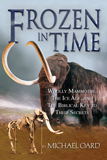Kids Mode
This will turn off kids mode. Are you age 13 or older?
How to Read an Ice Core
Ice Age Exhibits
on January 9, 2017Most ice cores are alleged to show hundreds of thousands of annual layers.
However, meteorologist Michael Oard points out that precipitation levels were much greater during the post-Flood Ice Age, resulting in a number of the core’s lower layers being built up annually. While he agrees that annual layers are discernible in the upper layers, he suggests that the lower layers do not represent individual annual layers.
… the uniformitarian and creationist estimates of annual thickness are much the same at the top of the Greenland ice sheet. The difference between the two models becomes more and more significant deeper in the ice core. Because of extreme annual layer thinning at the bottom of the core in the uniformitarian model compared to the creationist model, the uniformitarian scientists may be counting 100 layers that they think are annual. These layers in the creationist model may represent only one year. So, the uniformitarian scientists in actuality would be counting storm layers or other cycles of weather that can often duplicate the annual cycle. For instance, a storm has a warm and cold sector with different measurements of the variables, producing a cycle in the variables. These storm oscillations may be on the order of several days. Even the uniformitarian scientists recognize that storms and other phenomena, like moving snow dunes, may result in the counting of an annual cycle, …. (Frozen in Time, Master Books, 2004, chapter available online at www.answersingenesis.org/answers/books/frozen-in-time/do-ice-cores-show-many-tens-of-thousands-of-years/.)
Related Downloads
Ice Cores—Proof of Long Ages?
Audio DownloadMuseum Guide
Are you exasperated by all the hype about "millions of years" in secular museums? The Museum Guide will help!
Browse Kids BookRecommended Resources
- © 2025 Answers in Genesis
- Privacy Policy
- Contact
- About





